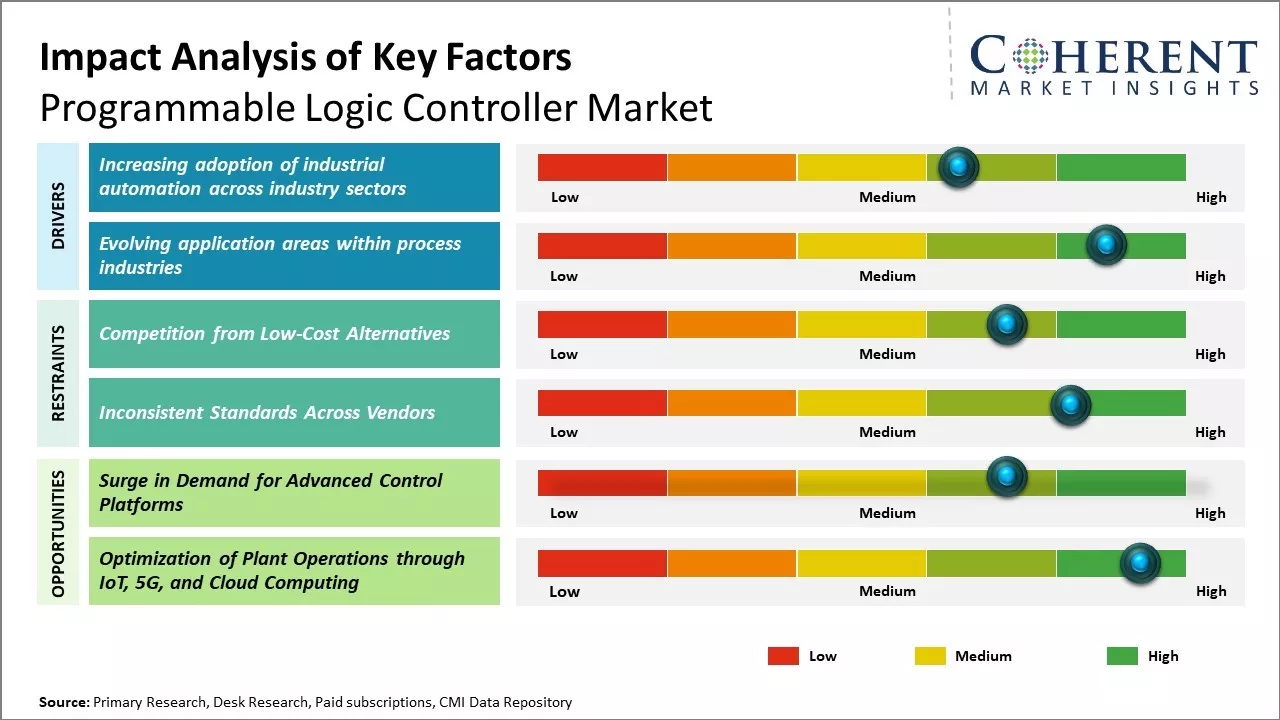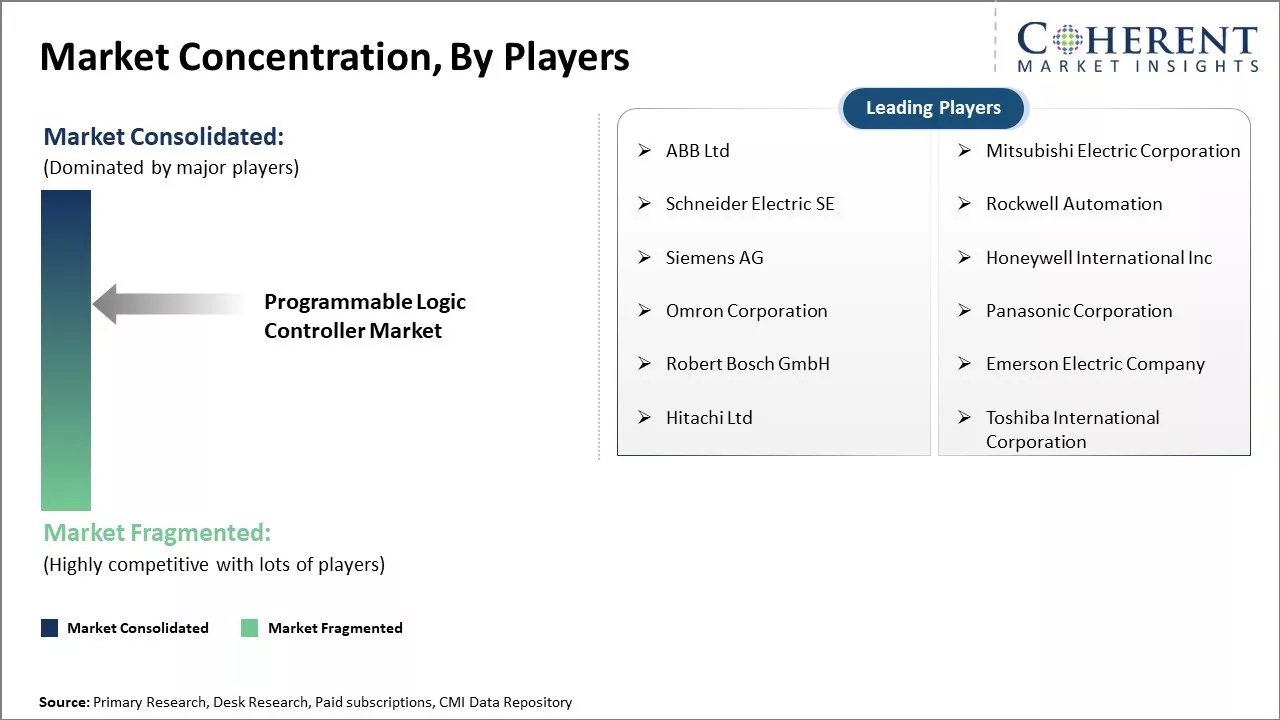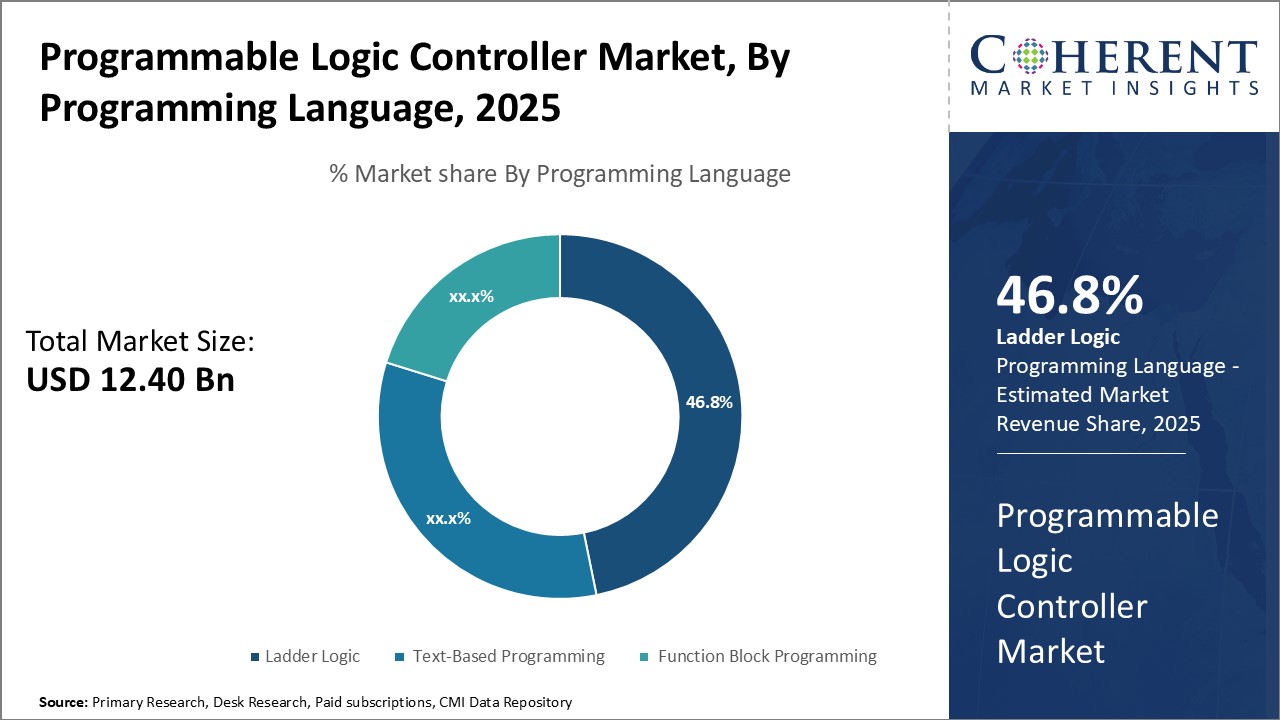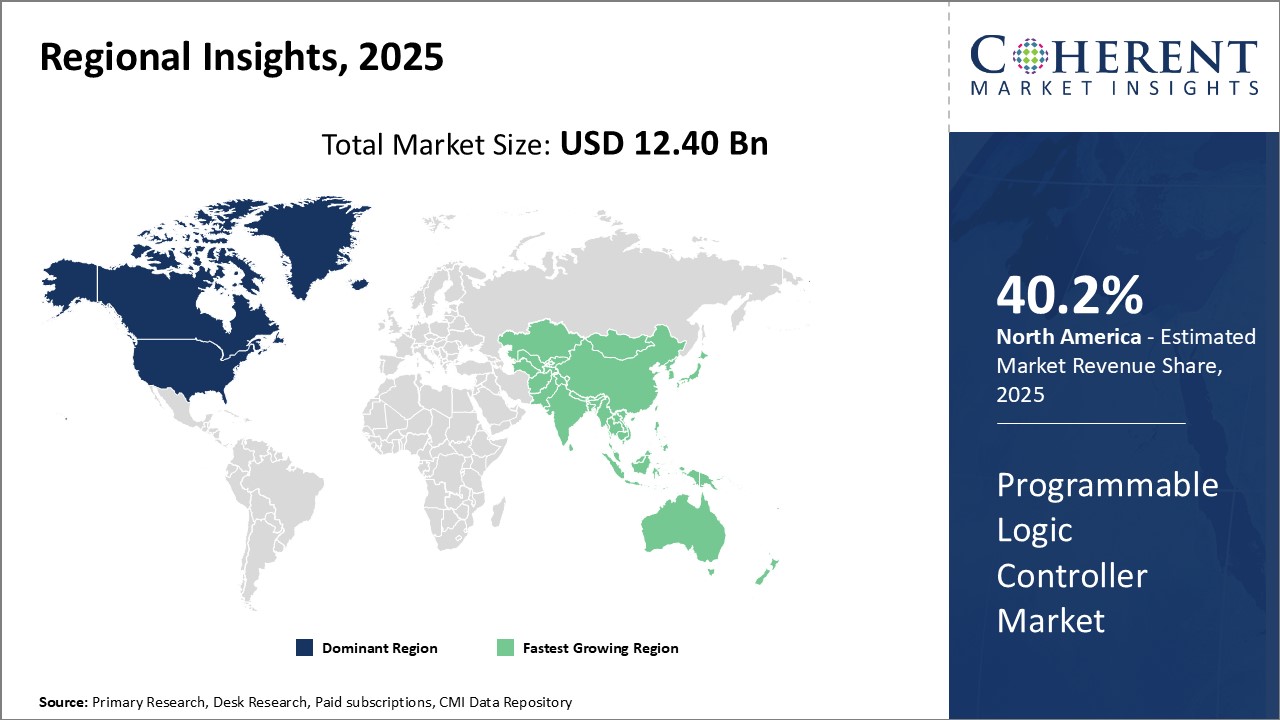The programmable logic controller market is estimated to be valued at USD 12.40 Billion in 2025 and is expected to reach USD 16.66 Billion by 2032, exhibiting a compound annual growth rate (CAGR) of 4.3% from 2025 to 2032.

Discover market dynamics shaping the industry: Request sample copy
The programmable logic controller market is expected to witness considerable growth over the forecast period. The growing industrial automation and adoption of digital technologies across industries will boost the adoption of PLC systems. Further, the need for improved operational efficiency and reducing production costs is increasing the deployment of automation equipment. Advancements in PLC like cloud connectivity, embedded IoT, and edge computing are expanding their application areas. Also, the development of 5G network infrastructure will enable more real-time analytics solutions leveraging PLC systems. The demand from food & beverages, oil & gas, automotive and other process industries will continue driving opportunities for vendors. However, threat from software-based controllers may hamper hardware PLC revenues to some extent. Overall, rapid industrialization globally is expected to propel the programmable logic controller market forward.
Increasing adoption of industrial automation across industry sectors
The global manufacturing sector has been adopting industrial automation technologies at a rapid pace over the past decade. This is mainly driven by the need to enhance productivity and operational efficiency of production processes across industries. Programmable logic controllers (PLCs) form an integral part of industrial automation systems as they provide the processing and control capabilities needed to automate industrial processes and machinery. PLCs are increasingly being used to automate a wide range of manufacturing activities including assembly line operations, material handling equipment, machine tools, and packaging machinery.
The growing complexity of manufacturing operations is propelling the demand for PLCs that can handle more advanced control functions with ease. More factories are leveraging PLCs to achieve enhanced flexibility in production with capabilities like feedback control, motion control, and communication with other hardware. Industries that involve repetitive and mechanized processes like food and beverage, automotive, semiconductors and electronics have significantly increased their adoption of PLC controlled machines and equipment over the past few years. This trend is anticipated to continue as more machinery across industries integrates latest digital technologies. The rising need for mass customization is also driving manufacturers to install PLC controlled flexible manufacturing systems. The stringent quality and reliability standards across industries further strengthen the case for automation with advanced PLC systems.
For instance, in January 2020, Hitachi Ltd. a Japanese multinational conglomerate, acquired a robotic system integration provider, JR Automation, to enhance its automation solutions for the manufacturing industry, aiming to offer seamless integration processes to customers.

Get actionable strategies to beat competition: Request sample copy
Evolving application areas within process industries
Another key factor driving the Programmable Logic Controller Market is the increasing applications of programmable automation within various process industries. Process control has traditionally relied more on dedicated controllers and networked control systems. However, PLCs are now often preferred over alternative control system choices in many process automation uses due to their rugged nature and capacity to handle a diverse range of control requirements with ease.
PLCs are playing a greater role in optimizing complex processes within industries like chemicals, mining, oil and gas, pharmaceuticals, pulp and paper, and food and beverage. For example, in oil refineries, PLCs are used for controlling a wide array of critical unit operations and machinery. Their open architecture enables the easy integration of advanced process control and safety instrumentation functions. PLCs also offer advantages in the maintenance and diagnostics of process control systems. The rising demand for mass customization even within batch process manufacturing is driving more plants to deploy PLC controlled flexible processing systems. Mining operations also depend greatly on PLC automated heavy machinery for various on-site activities.
For instance, in July 2022, Omron Corporation a electronics company, developed CP2E Micro PLC designed for small devices, supporting data collection and machine-to-machine communication. CP2E is a highly effective solution for standalone machines where cost performance is crucial. This series of controllers offers an excellent option for flexible production environments that require machine monitoring and traceability.
Key Takeaways of Analyst:
The programmable logic controller market is poised to grow steadily over the next five years. The major drivers fueling this growth are increasing automation across industries and rising demand for robust industrial controllers. PLCs offer several advantages like flexibility, reliability, and adaptability which is driving their adoption over conventional hardwired controllers. Upgrade of aging infrastructure around the world also presents considerable opportunities for PLC vendors to replace outdated systems.
However, high initial investment remains a key restraint limiting the sales of PLCs for small and medium enterprises. The market also faces challenges from open-source alternatives which offer comparable functionality at reduced costs. Despite these bottlenecks, Asia Pacific is projected to be the fastest expanding regional market. This can be attributed to massive infrastructure modernization programs underway in China and India.
North America will continue dominating the global PLC landscape fueled by strong manufacturing sector and early technology adoption among process industries in the region. Significant emphasis on Industry 4.0 across Germany-based manufacturing is propelling Europe as the second largest Programmable Logic Controller Market. Meanwhile, the Middle East and Latin America offer lucrative prospects for market participants to tap the rising automation demand from the oil & gas industry.
In conclusion, while upfront costs pose challenges, the inherent benefits of PLC systems ensure steady replacement and new installation opportunities globally.
Market Challenges: Competition from Low-Cost Alternatives
Programmable logic controllers (PLCs) are facing a significant threat from low-cost microcontrollers and single-board computers. These alternative solutions offer similar control functionality at a much lower price point, making them attractive to cost-conscious manufacturers. This shift poses a major challenge for traditional PLC vendors who need to adapt their offerings to stay competitive.
Market Opportunities: Surge in Demand for Advanced Control Platforms
The growing demand for automated processes across various industries drives the need for more advanced control platforms. Emerging technologies such as IoT, 5G, and cloud computing open up possibilities to optimize plant operations from remote locations. The adoption of new communication protocols allows for integrating PLCs into more complex and interconnected systems, enhancing overall efficiency, scalability, and real-time data analysis capabilities. This integration facilitates improved decision-making, predictive maintenance, and seamless coordination across different industrial processes.

Discover high revenue pocket segments and roadmap to it: Request sample copy
Insights, By Programming language - Programming Efficiency and Versatility Drive Ladder Logic Adoption
In terms programming language, ladder logic is expected to contribute the highest share of 46.8% in 2025, owing to its simplicity and resemblance to traditional relay-based logic systems. Ladder Logic programming replicates the logic of relay-based circuits using vertical and horizontal lines to represent the circuits and connecting links. This makes it intuitive for engineers and technicians familiar with relay circuits to program PLCs using Ladder Logic. It allows application of control specifications with minimum retraining. Moreover, Ladder Logic programs can be easily understood and modified by other programmers as its basics are largely self-documenting. Organizations hence prefer Ladder Logic to train and deploy control engineers with minimum ramp up time. Its dominance in industrial control for decades has also made it compatible with a large pool of existing hardware and software components such as HMIs, drives, sensors, etc., thereby reducing integration challenges. While being efficient for basic control applications, Ladder Logic also supports features like timing, math, and advanced functions. This versatility has ensured its continued relevance across a wide range of industries beyond basic discrete control.
Insights, By Size - Economies of Scale and Modularity Drive Modular PLC Adoption
In terms of size of the programmable logic controller market, modular PLCs is expected to contribute the highest share of 35.32% in 2025, owing to economical scalability and modular design. Modular PLC systems provide flexibility to start small and scale up hardware and functionality by adding individual modules without replacing the main CPU. This allows optimized initial investment and pay-as-you-grow model according to evolving automation needs. Moreover, modular design with standardized communication protocols facilitate the replacement of faulty modules with spares from same or other vendors. This further reduces downtime and maintenance costs compared to non-modular PLCs. Large automation projects and distributed control applications also prefer modular PLCs for their ability to control distant field devices and I/O through scalable remote modular heads connected via industrial networks and fieldbuses. The modular architecture also supports the utilization of different modules suited for diverse field devices, communication interfaces, and applications all within same software programming environment for superior integration.
Insights, By Industry Vertical - Expanding Automation and Customization Drive PLC Adoption in Automotive Industry
In terms of industry vertical, the automotive segment is expected to contribute the highest share of 29.98% in 2025. This is attributed to increasing PLC adoption driven by rapid automation and customization needs of the automotive industry. Growing requirements of quality, productivity, and variant manufacturing are compelling automakers to deploy more automated assembly lines, machine tools, and robots. PLCs provide a flexible platform to orchestrate complex automated sequences, integrate diverse automation equipment and customize programs for changing product variants on same production lines. Furthermore, automotive OEMs and component manufacturers rapidly pilot new production technologies like 3D printing, collaborative robots, vision guided assembly that require integrated control solutions. PLCs ability to operate seamlessly across legacy and state-of-art systems facilitates such technology upgrades. Their open architecture also allows custom interface development for unique manufacturing requirements of automotive industry like body shops, paint booths, drive train assembly etc. With continuous innovation in automotive manufacturing processes, the adoption of PLCs is expected to further accelerate in automotive sector to achieve Industry 4.0 automation goals.

Need a Different Region or Segment? Customize now
North America is expected to hold the highest share of 40.2% in 2025. The region is home to some of the largest end-use industries that employ PLC technologies at a massive scale, such as automotive, oil & gas, food & beverage, and manufacturing. Many major PLC vendors have established their headquarters and largest R&D centers in the region to effectively cater to customers. With the presence of advanced industrial infrastructure and skilled workforce, North America provides fertile ground for piloting new PLC technologies. The region also has a highly developed ecosystem of system integrators and automation solution providers that help various process industries design and implement customized PLC-based systems.
Stringent regulatory standards around industrial safety have further propelled PLC adoption across critical industry sectors. With its large and mature industries, North America expects continued upgrades and expansion of existing automation infrastructure, driving robust demand for PLCs. The region also possesses manufacturing capabilities for a significant portion of PLC hardware components. This helps minimize import dependence and logistics costs for the supplier base. Overall, the combination of industrial leadership, supportive infrastructure and standards have helped North America maintain its stronghold in the global Programmable Logic Controller Market.
The Asia Pacific region has emerged as the fastest growing geographic market for PLCs globally with CAGR of 5.41% in 2025. Rapid industrialization initiatives underway across developing Asia Pacific countries like China, India and Southeast Asian nations have been the major growth driver. These countries are witnessing massive capital investments in building Greenfield industrial parks and modernizing existing factories. This has translated to exponential installations of new PLC-based automation systems for improving productivity and quality.
Additionally, the shift of manufacturing bases from developed nations to Asia Pacific provides impetus for technology transfers and further PLC adoption. National initiatives promoting 'Make in India' and 'Industry 4.0' adoption have positioned various Asia Pacific economies as global manufacturing powerhouses of the future. This positions the region well to sustain its momentum as the most promising regional market space over the coming years.
For Instance, Japan Market Insights: Japan holds the largest market share in the robot manufacturing industry and the implementation of industrial robots. According to the Japan Statistics Bureau, revenue from robots in Japan is expected to reach approximately USD 16.35 billion by 2024.
Programmable Logic Controller Market Report Coverage
| Report Coverage | Details | ||
|---|---|---|---|
| Base Year: | 2024 | Market Size in 2025: | USD 12.40 Bn |
| Historical Data for: | 2020 To 2024 | Forecast Period: | 2025 To 2032 |
| Forecast Period 2025 to 2032 CAGR: | 4.3% | 2032 Value Projection: | USD 16.66 Bn |
| Geographies covered: |
|
||
| Segments covered: |
|
||
| Companies covered: |
ABB Ltd, Mitsubishi Electric Corporation, Schneider Electric SE, Rockwell Automation, Siemens AG, Honeywell International Inc, Omron Corporation, Panasonic Corporation, Robert Bosch GmbH, Emerson Electric Company, Hitachi Ltd, and Toshiba International Corporation |
||
| Growth Drivers: |
|
||
| Restraints & Challenges: |
|
||
Uncover macros and micros vetted on 75+ parameters: Get instant access to report
*Definition: The Programmable Logic Controller (PLC) market encompasses companies that manufacture and sell PLCs and related hardware and software. PLCs are digital computers used for the automation of industrial processes like manufacturing, processes, and building automation. PLCs monitor inputs and make decisions based on a custom program to control outputs and machines. They are often used in industries like oil and gas, chemical, automotive, food and beverage processing, pulp and paper processing, electricity generation and distribution and others.
Share
Share
About Author
Monica Shevgan has 9+ years of experience in market research and business consulting driving client-centric product delivery of the Information and Communication Technology (ICT) team, enhancing client experiences, and shaping business strategy for optimal outcomes. Passionate about client success.
Missing comfort of reading report in your local language? Find your preferred language :
Transform your Strategy with Exclusive Trending Reports :
Frequently Asked Questions
Joining thousands of companies around the world committed to making the Excellent Business Solutions.
View All Our Clients
US Reciprocal Tax Impact Analysis On Programmable Logic Controller Market
Stay updated on tariff changes with expert insights and timely information